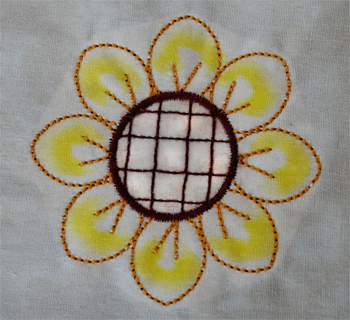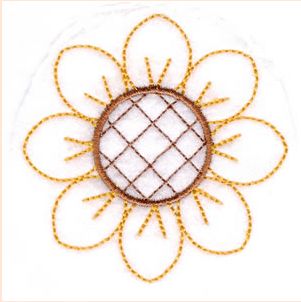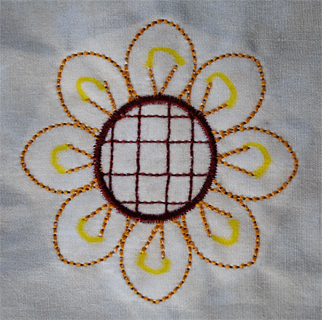
Like to color? Add a new dimension to traditional embroidery with fabric painting.
I first read about fabric painting in an Anita Goodesign newsletter. The idea is to stitch an outline design and color it, giving it a watercolor appearance. They used Copic markers and a Copic blending tool which work quite well but are a bit pricy. I wondered about using Sharpie permanent markers and rubbing alcohol as a blending agent and found a later newsletter article which did just that. Further research on the Internet turned up several YouTube videos.
While reading some past blogs, I found one by Pat that described the bean stitch, a triple stitch used primarily as a design outline. When I saw the featured design by Terradonembroidery.com, I knew it would be perfect for embroidery painting. Fortunately, Terri Hanson from Terradon kindly resurrected the design and has added it to her site.

So with some very simple and inexpensive supplies, you can easily create watercolor embroidery. All you need is a stitched outline design, rubbing alcohol, Sharpie fine point permanent markers, and cotton swabs.

Be sure to work on a waterproof surface (a garbage bag works well) to prevent damage to your table top. I used an off-white cotton marbled fabric for additional color variation and cotton thread to further emphasize texture in the stitches.
Try to stay in the lines. Play around with the markers and alcohol on a scrap of fabric the same as that which you stitched to see how the colors blend. The cotton fabric acts as a wick to the alcohol, so it doesn't take much ink or alcohol to create color within the design. You don't want the color to extend outside the stitch area so err on the side of caution. You can always add color and alcohol but you can not take it away.
I added short arches to the inner petals, purposely keeping any added color central on the petal. Then, I dipped a cotton swab in alcohol and pressed it between the "V" at the base of the petals.

As the alcohol travels along the fabric, it draws the color along with it and the effects are like a watercolor painting!

Press with a hot, dry iron to set the colors.
Here are some other designs on Ann the Gran that would work well with this technique:
Have fun and don't forget to share your projects in the gallery!
Debbie SewBlest